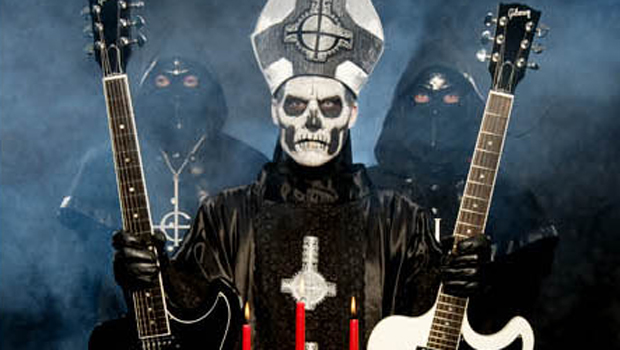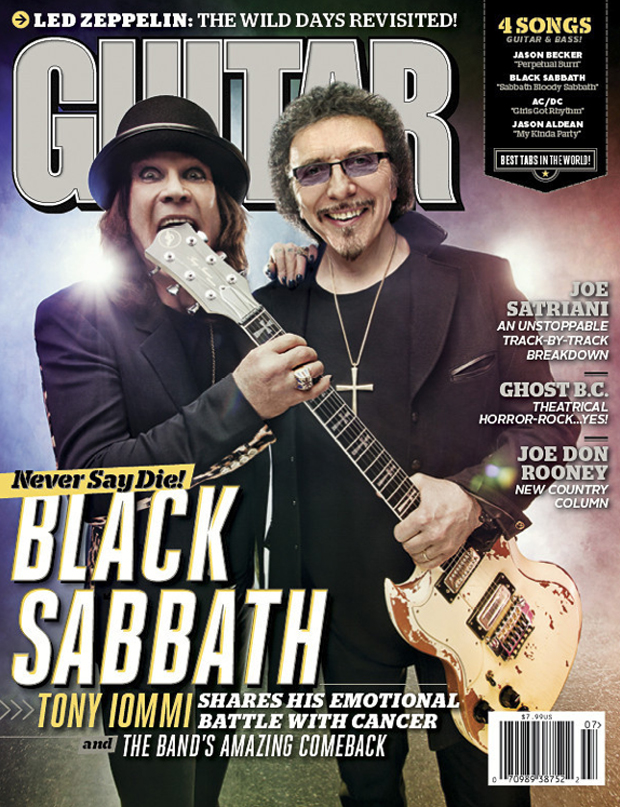Ghoul Intentions: Ghost B.C. Talk New Album, 'Infestissumam,' and Living in the Past

This is an excerpt from the July 2013 issue of Guitar World magazine. For the rest of this story, plus features on Black Sabbath, Joe Satriani, Led Zeppelin, Joe Don Rooney, Mick Jones and more, check out the issue at the Guitar World Online Store.
Ghost B.C. make like the past 40 years never happened. On their new album, Infestissumam, they show why fans like Dave Grohl and Metallica are glad to let them go on living in the past.
The night before he sat down with Guitar World, Ghost B.C.’s rhythm guitarist, Nameless Ghoul 2, was at home watching the 1968 Roman Polanski movie, Rosemary’s Baby, soaking in the film’s bizarre, satanic atmosphere.
It’s one of his favorites, along with The Exorcist and The Omen.
“What’s so great about Rosemary’s Baby is it’s not bloody or horrifying,” he says, two weeks before the release of Ghost B.C.’s second album, Infestissumam (Latin for hostile). “It’s just creepy and it gets under your skin.”
Aesthetically speaking, for Ghost B.C., the world hasn’t changed much since the late Sixties and early Seventies, when curiosity about the occult permeated mainstream society. Church of Satan founder Anton Szandor LaVey’s 1969 book The Satanic Bible was a best seller, Led Zeppelin were flirting with the teachings of Aleister Crowley, and Black Sabbath were about to release their self-titled debut, the most influential occult-themed album of its era.
“We’ve chosen to go backward as opposed to being more contemporary,” says the band’s lead guitarist, Nameless Ghoul 1. “Society was much more open-minded back then and music was far more exciting. The idea of Ghost was to pretend it was 1976 and metal didn’t really exist. We wanted to travel back to the magic and imagery of that era and present it in a theatrical and mysterious way.”
In concert, Ghost B.C.’s anonymous instrumentalists wear black hooded robes and never speak or look at one another. Vocalist Papa Emeritus II, meanwhile, appears in Papal regalia, his face painted to resemble a skull. The look is sinister and horrific, yet while the songs on Infestissumam are about the reign of the Antichrist, the music is majestic, melodic and seasoned with soaring choirs, church organ keyboards and kitschy horror-film soundtrack melodies.
“As opposed to a lot of proper black metal bands that ask everyone to kill themselves, and preferably kill someone else while they’re doing it, we are strictly an entertainment act,” Nameless Ghoul 1 explains. “And what we find entertaining is theatrical satanic horror-rock.”
The guitarists won’t reveal anything about their pre-Ghost past, other than to say they used to play in Swedish hardcore and death metal bands. However, they will openly discuss Ghost’s history, the challenges of rising from underground cult figures to mainstream entities, the creative process for Infestissumam and their methodical approach to sounding like a band from an era 40 years past.
Ghost formed as a retro-metal band in 2008 and spent three years cultivating their sound and image. “We knew we wanted to play live, but we felt the theatrics were too big to do in a pub circuit,” Nameless Ghoul 1. “So we decided to create our entire stage show before we actually started performing live.”
In 2010, Ghost cemented their stage gear, circulated a three-song demo and started playing shows. In June of that year, they released a single featuring the songs “Elizabeth” and “Death Knell,” both of which resurfaced that October on the band’s Rise Above Records/Metal Blade debut, Opus Eponymous. The album was recorded over the course of a few weeks at a basement studio in the band’s hometown. “We did the whole thing with a standard Gibson SG,” Nameless Ghoul 1 says. “We were much more limited then, which is why a lot of the guitars sound more traditionally metal on that album.”
“It was a good place to start and we learned a lot by experimenting,” Nameless Ghoul 2 adds. “We played everything through an Orange Thunderverb 50. To get a real Seventies vibe, we backed up the gain as much as possible without losing the tone or the sustain. We found that the midrange was really important as well. That’s why we used Orange amps.”
The most obvious influences for the album were Blue Öyster Cult, Deep Purple and Mercyful Fate. But Nameless Ghoul 1 says his leads on the album were equally influenced by the Doors, and not just guitarist Robby Krieger. “I think he’s an amazing player, but I would say a lot of the things Ray Manzarek did on the keyboard have been influential to me as a guitar player as well,” he says. “And, of course, I’m also inspired by the greats of classic rock: Jimmy Page, Tony Iommi, Jimi Hendrix and many others.”
“We’ve just always liked good songs, everything from Roy Orbison to Stevie Wonder to Black Sabbath,” Nameless Ghoul 2 adds. “We love good pop songs as much as great metal songs. That’s how we manage to fit between the two kinds of music.”
Not long after Opus Eponymous came out, a strong buzz developed around Ghost. Their retro approach stood out in a sea of interchangeable doom metal, and their ominous, dramatic stage show intrigued hipsters who weren’t traditionally drawn to metal concerts. To meet the growing demand, the band overextended itself.
Photo: Ester Segarra
This is an excerpt from the July 2013 issue of Guitar World magazine. For the rest of this story, plus features on Black Sabbath, Joe Satriani, Led Zeppelin, Joe Don Rooney, Mick Jones and more, check out the issue at the Guitar World Online Store.

Get The Pick Newsletter
All the latest guitar news, interviews, lessons, reviews, deals and more, direct to your inbox!
Jon is an author, journalist, and podcaster who recently wrote and hosted the first 12-episode season of the acclaimed Backstaged: The Devil in Metal, an exclusive from Diversion Podcasts/iHeart. He is also the primary author of the popular Louder Than Hell: The Definitive Oral History of Metal and the sole author of Raising Hell: Backstage Tales From the Lives of Metal Legends. In addition, he co-wrote I'm the Man: The Story of That Guy From Anthrax (with Scott Ian), Ministry: The Lost Gospels According to Al Jourgensen (with Al Jourgensen), and My Riot: Agnostic Front, Grit, Guts & Glory (with Roger Miret). Wiederhorn has worked on staff as an associate editor for Rolling Stone, Executive Editor of Guitar Magazine, and senior writer for MTV News. His work has also appeared in Spin, Entertainment Weekly, Yahoo.com, Revolver, Inked, Loudwire.com and other publications and websites.

